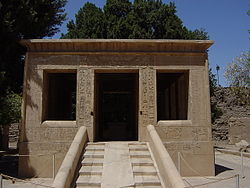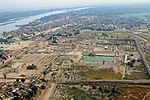| Revision as of 01:14, 12 October 2009 editUntwirl (talk | contribs)1,493 editsm Reverted 1 edit by 76.126.224.27 identified as vandalism to last revision by Untwirl. (TW)← Previous edit | Latest revision as of 08:12, 1 May 2024 edit undoNotaro da Lentino (talk | contribs)8 editsNo edit summary | ||
| (213 intermediate revisions by more than 100 users not shown) | |||
| Line 1: | Line 1: | ||
| {{Short description|Historic site in Egypt}} | |||
| ⚫ | |||
| {{Infobox historic site | |||
| ]]] | |||
| | name = White Chapel of Senosret I | |||
| | image = File:White Chapel.jpg | |||
| | caption = Northern facade of the White Chapel | |||
| | locmapin = Egypt | |||
| | map_caption = Open Air Museum, Karnak Temple | |||
| | built = 1971 BCE to 1926 BCE (Senusret)<ref name="madainwhitechapel">{{cite web |title=White Chapel of Senusret I |url=https://madainproject.com/white_chapel |website=Madain Project |access-date=21 May 2020}}</ref> | |||
| | demolished = 1390 BCE to 1352 BCE (Amenhotep III)<ref name="madainwhitechapel"></ref> | |||
| }} | |||
| ⚫ | {{other uses|Whitechapel (disambiguation)}} | ||
| The '''White Chapel''' of pharaoh ], also referred to as the ] ] of Senusret I, was built during the ]. During the ] it was demolished and used as filler for the Third Pylon of the temple of Karnak, ].<ref>{{cite book|title=Karnak: Evolution of a Temple|url=https://archive.org/details/karnakevolutiont00blyt|url-access=limited|first=Elizabeth|last=Blyth|page=|year=2006|publisher=Routledge|location=London}}</ref> | |||
| In 1927 the dismantled pieces were found inside the Third Pylon of the main temple, constructed in the time of ], at Karnak, and between 1927 and 1930 all of the pieces were carefully removed. These pieces were then assembled into the building that is seen today.<ref>Lacau & Chevrier 1969</ref> | In 1927, the dismantled pieces were found inside the Third Pylon of the main temple, constructed in the time of ], at ], and between 1927 and 1930 all of the pieces were carefully removed. These pieces were then assembled into the building that is seen today in the ].<ref>Lacau & Chevrier 1969</ref> | ||
| The |
The White Chapel is made of ]. Its columns hold reliefs of a very high quality, which are hardly seen elsewhere at Karnak, and depicts Pharaoh Senusret being crowned and embraced by ], ], ] and ]. | ||
| All along the base of the outer walls runs a series of reliefs depicting the |
All along the base of the outer walls runs a series of reliefs depicting the emblems and deities of the ], or provinces, of Egypt. On the western side are the nomes of ], and on the eastern side are the nomes of ]. | ||
| ==Images on the White Chapel== | |||
| <gallery> | |||
| File:Chapelle-blanche-detail-2.JPG|White chapel reliefs | |||
| File:Chapelle blanche-detail-5.JPG|White chapel reliefs | |||
| File:Nome L Col 17 19.jpg|Nomes shown on the White chapel | |||
| </gallery> | |||
| ==References== | ==References== | ||
| {{commons category|White Chapel of Senusret I}} | |||
| <references /> | |||
| {{reflist}} | |||
| ⚫ | *{{cite book|title=Une Chapelle de Sesostris 1er|first=Chevrier, H. |last=Lacau, P &|year=1969|publisher=Service des Antiquities, Cairo}} | ||
| *{{cite book|title=Une chapelle de Sésostris Ier à Karnak|first1=Alain|last1=Arnaudiès|first2=Nathalie|last2=Beaux|first3=Antoine|last3=Chéné|date=2015|publisher=Soleb|location=Paris|url= http://soleb.com/livres/chapelle-blanche/|isbn=9782918157236}} | |||
| ==External links== | |||
| ⚫ | *{{cite book|title=Une |
||
| * . | |||
| ⚫ | {{archaeology-stub}} | ||
| ⚫ | {{egypt-struct-stub}} |
||
| ⚫ | {{Egyptology-stub}} | ||
| {{Karnak Temple Navigation}} | {{Karnak Temple Navigation}} | ||
| {{coord|25|43| |
{{coord|25|43|13.20|N|32|39|25.79|E|region:EG_type:landmark|display=title}} | ||
| ] | |||
| ] | ] | ||
| ] | |||
| ] | |||
| ⚫ | {{NEast-archaeology-stub}} | ||
| ] | |||
| {{Africa-archaeology-stub}} | |||
| ok | |||
| ⚫ | {{egypt-struct-stub}} | ||
| ⚫ | {{Egyptology-stub}} | ||
Latest revision as of 08:12, 1 May 2024
Historic site in Egypt| White Chapel of Senosret I | |
|---|---|
 Northern facade of the White Chapel Northern facade of the White Chapel | |
| Built | 1971 BCE to 1926 BCE (Senusret) |
| Demolished | 1390 BCE to 1352 BCE (Amenhotep III) |
 | |
The White Chapel of pharaoh Senusret I, also referred to as the Jubilee Chapel of Senusret I, was built during the Middle Kingdom of Egypt. During the New Kingdom it was demolished and used as filler for the Third Pylon of the temple of Karnak, Precinct of Amun-Re.
In 1927, the dismantled pieces were found inside the Third Pylon of the main temple, constructed in the time of Amenhotep III, at Karnak, and between 1927 and 1930 all of the pieces were carefully removed. These pieces were then assembled into the building that is seen today in the Karnak Open Air Museum.
The White Chapel is made of limestone. Its columns hold reliefs of a very high quality, which are hardly seen elsewhere at Karnak, and depicts Pharaoh Senusret being crowned and embraced by Amun, Horus, Min and Ptah.
All along the base of the outer walls runs a series of reliefs depicting the emblems and deities of the nomes, or provinces, of Egypt. On the western side are the nomes of Upper Egypt, and on the eastern side are the nomes of Lower Egypt.
Images on the White Chapel
References
- ^ "White Chapel of Senusret I". Madain Project. Retrieved 21 May 2020.
- Blyth, Elizabeth (2006). Karnak: Evolution of a Temple. London: Routledge. p. 15.
- Lacau & Chevrier 1969
- Lacau, P &, Chevrier, H. (1969). Une Chapelle de Sesostris 1er. Service des Antiquities, Cairo.
{{cite book}}: CS1 maint: multiple names: authors list (link) - Arnaudiès, Alain; Beaux, Nathalie; Chéné, Antoine (2015). Une chapelle de Sésostris Ier à Karnak. Paris: Soleb. ISBN 9782918157236.
External links
| Karnak | |||||||
|---|---|---|---|---|---|---|---|
| General |  | ||||||
| Precincts |
| ||||||
| Aten Temple | |||||||
| Related | |||||||
25°43′13.20″N 32°39′25.79″E / 25.7203333°N 32.6571639°E / 25.7203333; 32.6571639
This article relating to archaeology in the Near East is a stub. You can help Misplaced Pages by expanding it. |
This African archaeology article is a stub. You can help Misplaced Pages by expanding it. |
This article about an Egyptian building or structure is a stub. You can help Misplaced Pages by expanding it. |
This article about Egyptology is a stub. You can help Misplaced Pages by expanding it. |


